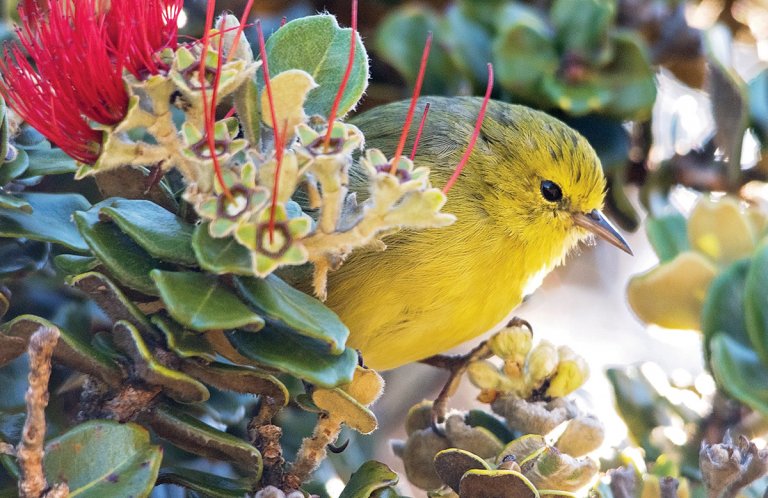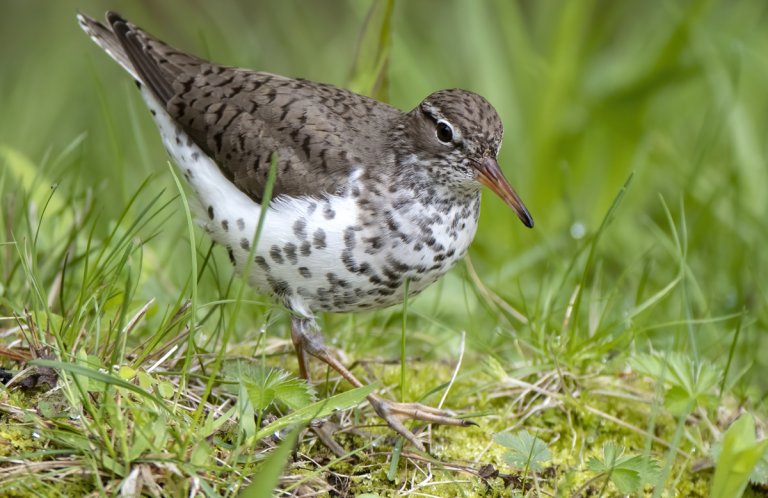
Northern Gannet range map by ABC
The eye-catching Northern Gannet is the largest seabird found in northern Atlantic waters — about the size of a Black-footed or Laysan Albatross — and belongs to the same family as Brown and Red-footed Boobies. It shares a similar pelagic lifestyle to these warm-water birds, spending most of its life in flight over the sea, coming to land only to nest.
The Northern Gannet's genus name Morus comes from the Ancient Greek word for "foolish," and refers to this bird's perceived fearlessness, particularly on its breeding grounds, where it can be easily approached. Its species name bassanus is a nod to the Bass Rock, an island off the east coast of Scotland where the largest breeding colony in the world can be found.
An adult Northern Gannet is easily identified by its large size and gleaming white plumage, accented by a golden-yellow head and neck and jet-black wingtips. Its long, narrow wings, tapered tail, and cigar-shaped body give it a distinctive shape in flight. And the way it hunts for food is also an unforgettable sight.
Diver Deluxe
The Northern Gannet hunts by "plunge-diving," flying up to 100 feet above the water, then plummeting toward the surface when it spots prey. It folds back its wings just before it slices into the sea, making a sleek, streamlined profile that produces little or no splash. This steep dive, which can reach speeds of 60 miles per hour, can propel the gannet as far as 16 feet under, like an avian torpedo. Once below the surface, the gannet can continue swimming after prey, using both its wings and webbed feet to dive as deep as 70 feet. It can stay submerged up to 30 seconds while hunting.
Several adaptations allow the Northern Gannet to regularly make these high dives. A reinforced skull, specially adapted neck muscles, and a bone plate at the base of the bill all help absorb impact with the water, while air sacs under the skin both help reduce initial impact and lend buoyancy, allowing this bird to pop back to the surface more easily. Binocular vision, facilitated by forward-facing eyes, allows the gannet to spot prey from high in the air and judge distances accurately as it dives. A gannet also has no external nostrils: These structures, located at the base of the bird's upper mandible, are concealed by a covering of hard tissue. This adaptation keeps water from being forced into the respiratory system during high-speed plunges.
Noisy Nesters
The Northern Gannet, true to its name, is mainly found along North Atlantic coasts of North America and Europe. Unlike far-ranging seabird species such as the White-tailed Tropicbird and Waved Albatross, Northern Gannets spend most of their lives relatively near coastlines and their breeding islands, rarely venturing more than 100 miles from shore.
More than half of the world's Northern Gannet population breeds around the coasts of Great Britain. In North America, this seabird nests in colonies on the coasts of northeastern Canada, wintering primarily from Maine south along the Atlantic and Gulf Coasts. Birders can sometimes spot lines of migrating gannets just off the beach during spring and fall migrations.
Northern Gannets seldom cross the Atlantic, so the eastern and western Atlantic populations stay mostly separate. There are two other gannet species, both with very similar coloration to the Northern: The Cape Gannet breeds off the coasts of South Africa and Namibia, and the Australasian Gannet nests off Australian and New Zealand shores.
The Northern Gannet is especially noisy at its nesting colonies, which resound with a deafening variety of raucous calls. At sea, this bird makes a softer call resembling that of a young Common Raven, giving rise to the German folk name of Seerabe (sea raven).
Listen to a gannet colony here:
(Audio: Jorick van Arneym, XC328163. Accessible at www.xeno-canto.org/328163)
Hunting From On High
A talented plunge-diver like many other seabirds ranging from the Brown Pelican to Royal Tern, the Northern Gannet preys chiefly upon on schooling fish, squid, and shrimp. A swirling and diving group of hunting Northern Gannets is an unforgettable sight, resembling an avian snowstorm, as dozens of the big white birds hover high in the air, arrow into the sea, and pop back to the surface.
The Northern Gannet also lands on the water to feed, dipping its head under or diving from the surface. It sometimes steals prey from other seabirds, and is pirated in turn by more aggressive birds such as skuas.
Northern Gannets often hunt in large groups in tandem with dolphins, whales, and seals, which drive schools of fish closer to the surface and within reach of the foraging birds. Like many seabirds, the gannet also follows fishing vessels for offal.
Gregarious Gannetries
The Northern Gannet is well-known for its huge, densely packed, and noisy breeding colonies, known as gannetries, which are located on steep cliffs, isolated rocky islands, or sea stacks (vertical columns of rock). Newly arriving males compete fiercely for good breeding spots, even to the point of fighting to the death. Once mated, a pair continues to defend its nesting site from neighbors by calling, displaying, and jabbing with their thick, heavy bills.
Northern Gannet pairs mate for life, and often return to the same area and nest each year. Pairs reinforce their bond through mutual preening, nape nibbling, and "fencing," where the pair knocks bills together. Both male and female build their mound-shaped nest out of seaweed, mud, and grasses, refurbishing and reusing the nest in subsequent years. Increasingly, nests also incorporate human-made materials such as plastic trash and fishing gear (see “Gannets Run a Gauntlet,” below).

Northern Gannet on nest with plastic. Photo by Ondrej Prosicky, Shutterstock
The female gannet lays a single blue-green egg, and both male and female take turns brooding it beneath their webbed feet. The egg hatches into a featherless, helpless chick, which requires constant tending and feeding from the parental pair. The hatchling grows quickly, and by the time it fledges it's too chubby to fly far, instead gliding down to the ocean, where it remains on the water's surface for several weeks, sustained by its fat stores while it exercises its flight muscles and learns to dive. Once it leaves the nest, a young gannet is on its own.
Juvenile Northern Gannets are dark gray with scattered white feathers. They become whiter with each molt, and reach adult plumage by three to four years old. Even then, young gannets usually spend another few years unpaired until they can carve out and defend a nest site, find a mate, and begin to breed.
Gannets Run a Gauntlet
Northern Gannet eggs and chicks were once harvested extensively by people for food. Today, populations are healthy and even increasing. Nevertheless, this big seabird is vulnerable to a number of manmade threats. Northern Gannets often become ensnared in fishing nets or are snagged on the baited hooks of longline fisheries as they hunt, then pulled underwater to drown. Gannets often incorporate plastic litter, particularly fishing line and netting, into nests, where it may fatally entangle adults and young. These birds are also affected by pesticides and other toxins, which accumulate in their fish prey.
ABC is working to mitigate these threats through its Seabird Program, particularly its fisheries projects, which encourage new technologies, policy changes, and consumer action.
We have created a comprehensive guide, "Seabird Bycatch Solutions," and provide an interactive web-based tool, both to help fisheries managers assess threats and avoid accidentally catching seabirds.
Our Pesticides Program is also working to limit and/or cancel the most harmful toxins to birds.
Donate to support ABC's conservation mission!



















































